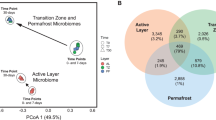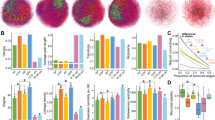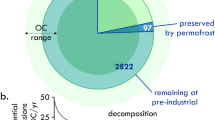Abstract
Insight into the effects of repeated freezing and thawing on microbial processes in sediments and soils is important for understanding sediment carbon cycling at high latitudes acutely affected by global warming. Microbial responses to repeated freeze–thaw conditions were studied in three complementary experiments using arctic sediment collected from an intertidal flat that is exposed to seasonal freeze–thaw conditions (Ymerbukta, Svalbard, Arctic Ocean). The sediment was subjected to oscillating freeze–thaw incubations, either gradual, from −5 to 4 °C, or abrupt, from −20 to 10 °C. Concentrations of low-molecular weight carboxylic acids (volatile fatty acids) were measured and sulfate reduction was assessed by measuring 35S sulfate reduction rates (SRRs). Gradual freeze–thaw incubation decreased microbial activity in the frozen state to 0.25 % of initial levels at 4 °C, but activity resumed rapidly reaching >60 % of initial activity in the thawed state. Exposure of sediments to successive large temperature changes (−20 versus 10 °C) decreased SRR by 80% of the initial activity, suggesting that a fraction of the bacterial community recovered rapidly from extreme temperature fluctuations. This is supported by 16S rRNA gene-based denaturing gradient gel electrophoresis profiles that revealed persistence of the dominant microbial taxa under repeated freeze–thaw cycles. The fast recovery of the SRRs suggests that carbon mineralization in thawing arctic sediment can resume without delay or substantial growth of microbial populations.
Similar content being viewed by others
Log in or create a free account to read this content
Gain free access to this article, as well as selected content from this journal and more on nature.com
or
References
Albert DB, Martens CS . (1997). Determination of low-molecular-weight organic acid concentrations in seawater and pore-water samples via HPLC. Mar Chem 56: 27–37.
Arnosti C, Jørgensen BB, Sagemann J, Thamdrup B . (1998). Temperature dependence of microbial degradation of organic matter in marine sediments: polysaccharide hydrolysis, and sulfate reduction. Mar Ecol Prog Ser 165: 58–70.
D’Amico S, Collins T, Marx JC, Feller G, Gerday C . (2006). Psychrophilic microorganisms: challenges for life. EMBO Rep 7: 385–389.
Deluca TH, Keeney DR, McCarty GW . (1992). Effects of freeze–thaw events on mineralization of soil nitrogen. Biol Fertil Soils 14: 116–120.
Eriksson M, Ka JO, Mohn WW . (2001). Effects of low temperature and freeze-thaw cycles on hydrocarbon biodegradation in Arctic tundra soil. Appl Environ Microbiol 67: 5107–5112.
Finke N . (2003). The role of volatile fatty acids and hydrogen in the degradation of organic matter in marine sediments, PhD Thesis, Department of Geology, University of Bremen, Bremen.
Finke N, Jørgensen BB . (2008). Response of fermentation and sulfate reduction to experimental temperature changes in temperate and Arctic marine sediments. ISME J 2: 815–829.
Gilichinsky DE, Soina VS, Petrova MA . (1993). Cryoprotective properties of water in the earth cryolithosphere and its role in exobiology. Orig Life Evol Biosph 23: 65–75.
Grogan P, Michelsen A, Ambus P, Jonasson S . (2004). Freeze–thaw regime effects on carbon and nitrogen dynamics in subarctic heath tundra mesocosms. Soil Biol Biochem 36: 641–654.
Helmke E, Weyland H . (2004). Psychrophilic versus psychrotolerant bacteria. Occurrence and significance in polar and temperate marine habitats. Cell Mol Biol 50: 553–561.
Jakobsson M, Grantz A, Kristoffersen Y, Macnab R . (2002). Physiographic provinces of the Arctic Ocean seafloor. Geol Soc Am Bull 115: 1443–1455.
Jørgensen BB . (1978). A comparison of methods for the quantification of bacterial sulfate reduction in coastal marine sediments. I. Measurement with radiotracer techniques. Geomicrobiol J 1: 11–27.
Junge K, Eicken H, Deming JW . (2004). Bacterial activity at −2 to −20 °C in Arctic wintertime sea ice. Appl Environ Microbiol 70: 550–557.
Kallmeyer J, Ferdelman TG, Weber A, Fossing H, Jørgensen BB . (2004). A cold chromium distillation procedure for radiolabeled sulfide applied to sulfate reduction measurements. Limnol Oceanogr Methods 2: 171–180.
Koponen H, Jaakkola T, Keinänen-Toivola MM, Kaipainen S, Tuomainen J, Servomaa K . (2006). Microbial communities, biomass, and activities in soils as affected by freeze thaw cycles. Soil Biol Biochem 38: 1861–1871.
Larsen KS, Jonasson S, Michelsen A . (2002). Repeated freeze–thaw cycles and their effects on biological processes in two arctic ecosystem types. Appl Soil Ecol 21: 187–195.
Lipson AD, Schmidt KS, Monson KL . (2000). Carbon availability and temperature control the post-snowmelt decline in alpine soil microbial biomass. Soil Biol Biochem 32: 441–448.
Männistö M, Tiirola M, Häggblom MM . (2009). Effect of freeze-thaw cycles on bacterial communities of Arctic tundra soil. Microb Ecol 58: 621–631.
Moritz ER, Bitz MC, Steig JE . (2002). Dynamics of Recent Climate Change in the Arctic. Science 297: 1497–1502.
Mountfort DO, Kaspar HF, Asher RA, Sutherland D . (2003). Influences of pond geochemistry, temperature, and freeze–thaw on terminal anaerobic processes occurring in sediments of six ponds of the McMurdo Ice Shelf, near Bratina Island, Antarctica. Appl Environ Microbiol 69: 583–592.
Muyzer G, Brinkhoff T, Nübel U, Santegoedes C, Schäfer H, Wawer C . (1997). Denaturing gradient gel electrophoresis (DGGE) in microbial ecology. In: Akkermans ADL, van Elsas JD, FJ de Bruijn (eds). Molecular Microbial Ecology Manual vol. 3.4.4. Kluwer: Dordrecht, The Netherlands, pp 1–27.
Nedwell DB . (1999). Effect of low temperature on microbial growth: lowered affinity for substrates limits growth at low temperature. FEMS Microb Ecol 30: 101–111.
Nedwell DB, Rutter M . (1994). Influence of temperature on growth rate and competition between two psychrotolerant Antarctic bacteria: Low temperature diminishes affinity for substrate uptake. Appl Environ Microbiol 60: 1984–1992.
Nordli Ø . (2005). Temperature variations at Svalbard during the last century. Nordicspace 13: 6–7.
Pernthaler A, Pernthaler J, Amann R . (2002). Fluorescence in situ hybridization and catalyzed reporter deposition for the identification of marine bacteria. Appl Environ Microbiol 68: 3094–3310.
Nübel U, Garcia-Pichel F, Kühl M, Muyzer G . (1999). Spatial scale and the diversity of benthic cyanobacteria and diatoms in a salina. Hydrobiologia 401: 199–206.
Pesaro MF, Widmer F, Nicollier G, Zeyer J . (2003). Effects of freeze–thaw stress during soil storage on microbial communities and methidathion degradation. Soil Biol Biochem 35: 1049–1061.
Ponder MA, Gilmour SJ, Bergholz PW, Mindock CA, Hollingsworth R, Thomashow MF, Tiedje JM . (2005). Characterization of potential stress responses in ancient Siberian permafrost psychroactive bacteria. FEMS Microbiol Ecol 53: 103–115.
Rachold V, Grigoriev MN, Are FE, Solomon S, Reimnitz E, Kassens H, Antonow M . (2000). Coastal erosion vs riverine sediment discharge in the Arctic shelf seas. Int J Earth Sci 89: 450–460.
Ravenschlag K, Sahm K, Knoblauch C, Jørgensen BB, Amann R . (2000). Community structure, cellular rRNA content and activity of sulfate reducing bacteria in marine Arctic sediments. Appl Environ Microbiol 66: 3590–3600.
Rivkina EM, Friedmann EI, McKay CP, Gilichinsky D . (2000). Metabolic activity of permafrost bacteria below the freezing point. Appl Environ Microbiol 66: 3230–3233.
Robador A, Brüchert V, Jørgensen BB . (2009). The impact of temperature change on the activity and community composition of sulfate-reducing bacteria in arctic versus temperate marine sediments. Environ Microbiol 11: 1692–1703.
Sagemann J, Jørgensen BB, Greef O . (1998). Temperature dependence and rates of sulfate reduction in cold sediments of Svalbard, Arctic Ocean. Geomicrobiol J 15: 85–100.
Schimel JP, Clein SJ . (1996). Microbial response to freeze–thaw cycles in tundra and taiga soils. Soil Biol Biochem 28: 1061–1066.
Schimel JP, Mikan C . (2005). Changing microbial substrate use in Arctic tundra soils through a freeze–thaw cycle. Soil Biol Biochem 37: 1411–1418.
Schuur EAG, Vogel JG, Crummer KG, Lee H, Sickman JO, Osterkamp TE . (2009). The effect of permafrost thaw on old carbon release and net carbon exchange from tundra. Nature 459: 556–559.
Semiletov IP, Pipko II, Repina I, Shakhova NE . (2007). Carbonate chemistry dynamics and carbon dioxide fluxes across the atmosphere–ice–water interfaces in the Arctic Ocean: Pacific sector of the Arctic. J Mar Sys 66: 204–226.
Sharma S, Szele Z, Schilling R, Munch JC, Schloter M . (2006). Influence of freeze–thaw stress on the structure and function of microbial communities and denitrifying populations in soil. Appl Environ Microbiol 72: 2148–2154.
Yergeau E, Kowalchuk AG . (2008). Responses of Antarctic soil microbial communities and associated functions to temperature and freeze–thaw cycle frequency. Environ Microbiol 10: 2223–2235.
Walker VK, Palmer GP, Voordouw G . (2006). Freeze–thaw tolerance and clues to the winter survival of a soil community. Appl Environ Microbiol 72: 1784–1792.
Widdel F, Hansen TA . (1991). The dissimilatory sulphate and sulphur-reducing bacteria. In: The Prokaryotes Vol II, 2nd edn. Springer: New York, pp 583–624.
Acknowledgements
We thank N Riedinger for fruitful discussions, and Captain S Henningsen and first mate J Mortensen of MS FARM, as well as the scientific party 2007 and 2008 for the successful expeditions. We also thank the Koldewey Station for support in Ny Alesund, Svalbard (project KOP56; RIS ID 3298). This study is funded by the Deutsche Forschungsgemeinschaft (DFG) Schwerpunktprogramm ‘The impact of climate variability on aquatic ecosystems (AQUASHIFT)’ BR 2174/1-1 and BR 2174/1-2 and Max Planck Society.
Author information
Authors and Affiliations
Corresponding author
Rights and permissions
About this article
Cite this article
Sawicka, J., Robador, A., Hubert, C. et al. Effects of freeze–thaw cycles on anaerobic microbial processes in an Arctic intertidal mud flat. ISME J 4, 585–594 (2010). https://doi.org/10.1038/ismej.2009.140
Received:
Accepted:
Published:
Issue date:
DOI: https://doi.org/10.1038/ismej.2009.140
Keywords
This article is cited by
-
Freeze-thaw cycles alter the growth sprouting strategy of wetland plants by promoting denitrification
Communications Earth & Environment (2023)
-
Responses of soil microbial communities to freeze–thaw cycles in a Chinese temperate forest
Ecological Processes (2021)
-
Activity and community structures of sulfate-reducing microorganisms in polar, temperate and tropical marine sediments
The ISME Journal (2016)
-
Characterization of the prokaryotic diversity through a stratigraphic permafrost core profile from the Qinghai-Tibet Plateau
Extremophiles (2016)
-
Contrasting denitrifier communities relate to contrasting N2O emission patterns from acidic peat soils in arctic tundra
The ISME Journal (2012)



